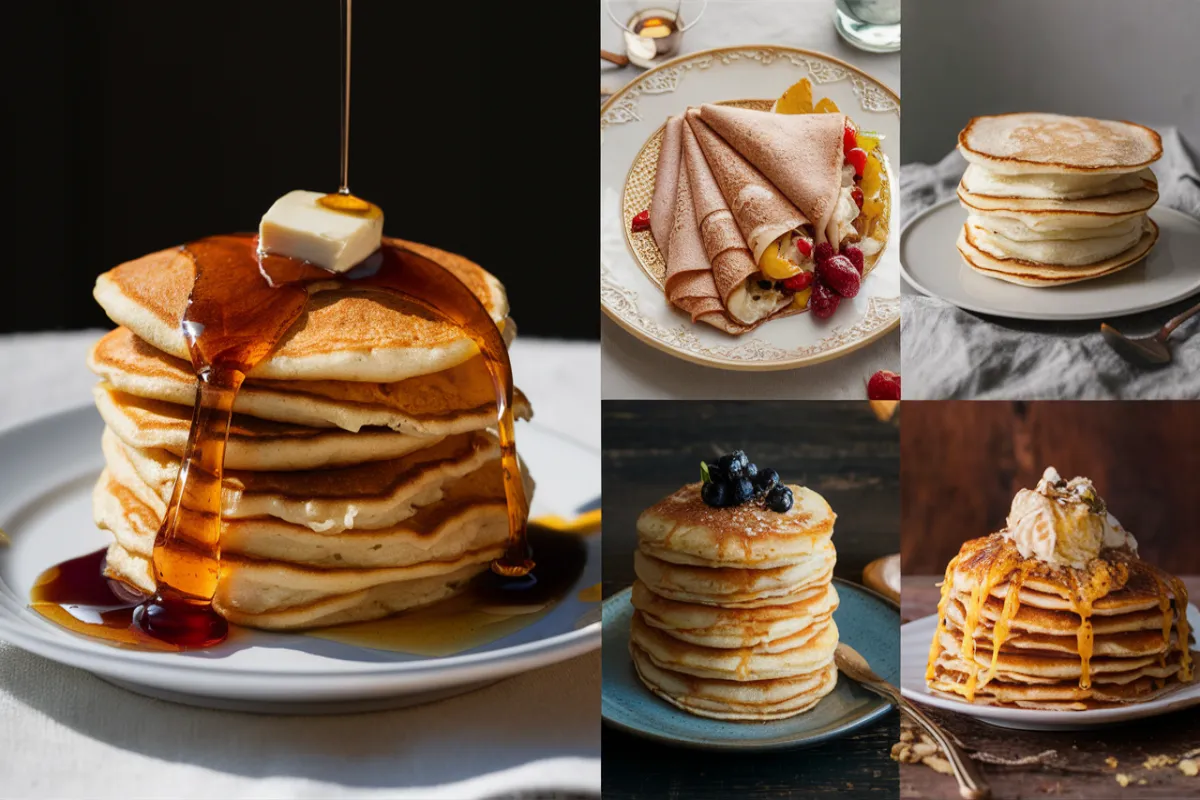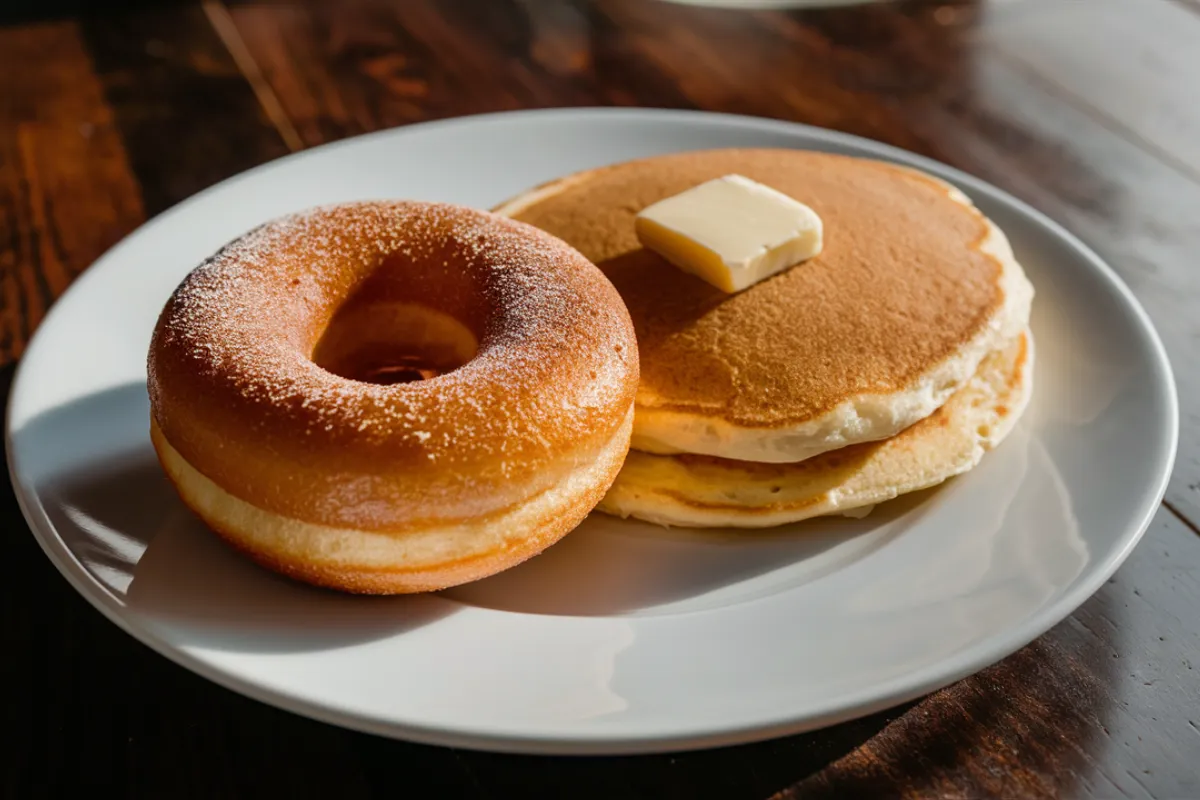When it comes to sweet breakfast treats or delicious snacks, what’s the difference between a donut and a pancake? This question often stirs up confusion because both donuts and pancakes are incredibly popular across the world, often served during breakfast or enjoyed as desserts. However, the two have their own unique characteristics that set them apart. From texture and flavor to preparation and how they are enjoyed, donuts and pancakes have distinct differences. This article explores these differences to clarify this culinary debate.
Texture and Structure
Donut Texture
One of the primary differences between a donut and a pancake lies in their texture. Donuts feature a firm, dense, and sometimes crispy exterior, depending on whether they are fried or baked. The inside of a donut typically feels soft and fluffy while maintaining its shape and offering chewiness. Frying donuts gives them a slight crunch on the outside, which contrasts with the tender, doughy interior. The structure of donuts is often more complex due to the specific methods used during preparation, setting them apart from pancakes.
Pancake Texture
Pancakes, by contrast, are known for their soft, fluffy, and cake-like texture. They are flat, round, and tender, with an almost melt-in-your-mouth quality. A lighter batter creates a smooth, golden-brown surface as pancakes cook on a griddle or pan. Their airy texture develops small bubbles during cooking, making them delicate and easy to slice. Unlike donuts, pancakes lack a firm or crispy exterior. The softness of pancakes has made them a favorite breakfast item across the world.
Preparation and Cooking Methods
Donut Cooking Method
Another clear distinction in what’s the difference between a donut and a pancake lies in their preparation and cooking methods. Donuts begin by shaping dough into a round form, often with a hole in the center, before frying in hot oil. While some donuts may be baked, frying remains the traditional method, giving donuts their signature crispy exterior and soft interior. Frying also contributes to the golden-brown color. After cooking, bakers fill some donuts with cream or jam, while others glaze or sprinkle them with powdered sugar.
Pancake Cooking Method
Pancakes, on the other hand, involve pouring batter onto a hot, greased griddle or pan, where it spreads into a flat, round shape. The process ensures that both sides turn golden-brown, with the cook flipping them midway through. Unlike donuts, pancakes do not undergo frying, so their surface remains soft and tender. The simplicity and speed of pancake preparation make them a popular choice for a quick breakfast.
Sweetness and Flavor
Donut Flavor
When considering what’s the difference between a donut and a pancake, flavor is another key distinction. Donuts tend to be much sweeter than pancakes because of the sugar content in the dough and the various toppings that enhance their sweetness. Donuts often come glazed, dusted with powdered sugar, or filled with sweet creams or jams, making them a decadent treat. Depending on the toppings or fillings, the sweetness of a donut can vary in intensity. Additionally, flavors like cinnamon, chocolate, or coffee are often present in many donuts, adding richness to the overall taste.
Pancake Flavor
Pancakes, though sweet, offer a more subtle sweetness compared to donuts. Pancake batter contains sugar, eggs, and milk, but the sweetness remains mild. The majority of the flavor comes from toppings added after cooking, such as maple syrup, butter, or fruit. Unlike donuts, pancakes allow for a wide range of sweet and savory toppings. This adaptability is one of the reasons pancakes serve as such a versatile breakfast dish, suitable for any time of the day.
Size and Shape
Donut Size and Shape
The size and shape of donuts are also notable when comparing what’s the difference between a donut and a pancake. Donuts are generally round and often feature a hole in the center. Though small and handheld, they pack a sweet punch, making them ideal for snacking. The hole serves a functional purpose, helping the dough cook evenly.
Pancake Size and Shape
Pancakes, however, are usually larger and flat, without any holes in the center. Pancakes are often stacked during breakfast and can range from small, silver-dollar pancakes to large, plate-sized servings. they achieve their round, flat shape naturally as the batter spreads across the griddle, while donuts rely on more structured shaping before cooking.
Toppings and Fillings
Donut Toppings and Fillings
Toppings and fillings play a major role in what’s the difference between a donut and a pancake. Donuts often feature an array of toppings, ranging from simple sugar glazes to elaborate sprinkles, icing, or chocolate. Many donuts feature creamy or fruity fillings, which deepen their flavor. These elements make donuts more of a dessert-like treat, with many variations that cater to sweet cravings.
Pancake Toppings
Pancakes are generally served with a variety of toppings rather than fillings. Butter, maple syrup, fresh fruit, and whipped cream are popular pancake accompaniments. Pancakes can also be topped with savory items such as bacon or sausage, making them a versatile dish that can balance sweet and savory flavors. Unlike donuts, toppings for pancakes are typically added after cooking, allowing for endless combinations.
Occasions and Serving Styles
Donut Occasions and Serving Styles
The occasions and serving styles of each treat further highlight what’s the difference between a donut and a pancake. Donuts are most commonly enjoyed as a snack or dessert, often paired with coffee or tea. They are also popular breakfast items, especially when eaten on the go. Donuts are frequently found in cafes, bakeries, and specialty donut shops, appealing to those who enjoy a sweet, portable treat.
Pancake Occasions and Serving Styles
Pancakes, by contrast, are traditionally associated with breakfast or brunch but can also be enjoyed for dinner. they are often served as a main dish, sometimes alongside eggs, bacon, or sausage. People typically eat pancakes in a sit-down setting, whether at home or in restaurants, and their larger size and heartier nature make them more of a meal than a snack.
Regional Variations
Donut Variations

Regional variations also play a significant role in distinguishing what’s the difference between a donut and a pancake. Different countries and regions offer many forms of donuts. For example, in France, you will find beignets—square-shaped, fried dough pastries dusted with powdered sugar. In Italy, there are bomboloni, which are filled with cream or custard. These variations show how adaptable and popular donuts are across different cultures.
Pancake Variations

Similarly, pancakes have their own global variations. In the United States, pancakes are often fluffy and served with syrup, while in France, crepes are thin pancakes that can be filled with a variety of sweet or savory ingredients. In Japan, soufflé pancakes are light, airy, and thick, offering a unique twist on the traditional pancake. These regional differences illustrate the versatility of pancakes and their universal appeal.
Frequently Asked Questions (FAQs)
What’s the difference between a donut and a pancake in terms of texture?
The main difference in texture between a donut and a pancake is that donuts are firmer and denser, often featuring a crispy exterior, while pancakes are soft, fluffy, and cake-like. Donuts offer a chewy bite, whereas pancakes are lighter and more delicate.
How do the flavors of donuts and pancakes differ?
Donuts tend to have a more intense sweetness, especially when topped with glaze, sugar, or filled with cream or jam. Pancakes offer a milder sweetness and typically rely on toppings like syrup or fruit for flavor enhancement.
Are donuts or pancakes more versatile in terms of toppings?
While both donuts and pancakes offer versatility in toppings, donuts often feature more elaborate options such as glazes, sprinkles, and fillings. Pancakes commonly get topped with syrup, butter, or fruit, but savory toppings are also popular.
Can donuts be served as a meal, like pancakes?
Donuts are generally enjoyed as snacks or desserts, while pancakes are typically served as a main breakfast or brunch dish, often accompanied by sides like bacon or eggs.
How do the serving occasions differ for donuts and pancakes?
Donuts are often served as snacks or treats and are frequently eaten on the go. Pancakes, on the other hand, are traditionally served as a sit-down breakfast or brunch meal, often in a more relaxed setting.
Conclusion
Texture Differences in Donuts and Pancakes
In conclusion, what’s the difference between a donut and a pancake comes down to texture, flavor, preparation, and how they are enjoyed. When it comes to texture, what’s the difference between a donut and a pancake is clear. Donuts are denser and sweeter, with a crispy exterior, while pancakes are soft, fluffy, and offer a wider range of toppings. What’s the difference between a donut and a pancake in terms of flavor is also significant. Donuts often have a stronger sweetness, especially when glazed, while pancakes deliver a milder, more subtle sweetness, which depends heavily on the toppings.
Preparation and Cooking Styles
In terms of preparation, what’s the difference between a donut and a pancake involves how donuts are fried to develop their crispy exterior, while pancakes are cooked on a griddle to achieve their soft and fluffy texture. This difference is crucial in understanding what’s the difference between a donut and a pancake, as it leads to the distinctive experiences offered by both. When discussing what’s the difference between a donut and a pancake, we must also consider their versatility. Donuts tend to feature elaborate toppings and fillings, but what’s the difference between a donut and a pancake is that pancakes allow for a wider variety of savory or sweet combinations.
Serving Occasions and Regional Variations
People often debate what’s the difference between a donut and a pancake in terms of their occasions and serving styles. Donuts are quick snacks, while pancakes serve as sit-down meals, reinforcing what’s the difference between a donut and a pancake during breakfast or brunch. As for regional variations, what’s the difference between a donut and a pancake can vary depending on cultural influences. In some countries, what’s the difference between a donut and a pancake may be subtle, but donuts and pancakes remain distinctly different worldwide. Whether served as snacks or meals, what’s the difference between a donut and a pancake continues to be a topic of interest for food lovers.
Personal Preferences and Key Takeaways
In essence, what’s the difference between a donut and a pancake boils down to personal preference and context. Donuts are beloved for their sweetness and portability, while pancakes are favored for their comforting, filling qualities. Whether you prefer donuts or pancakes, knowing what’s the difference between a donut and a pancake can help you choose the perfect option for your breakfast, snack, or dessert. In the end, what’s the difference between a donut and a pancake may seem small, but these differences make each treat special in its own way.
Final Thoughts
If you’re still wondering what’s the difference between a donut and a pancake, remember this: donuts offer a crispy, sweet indulgence, while pancakes deliver soft, versatile comfort. No matter what your preference is, understanding what’s the difference between a donut and a pancake can help you enjoy both treats to the fullest. So, whether you crave donuts or pancakes, keep in mind what’s the difference between a donut and a pancake as you indulge in either of these delightful foods.

